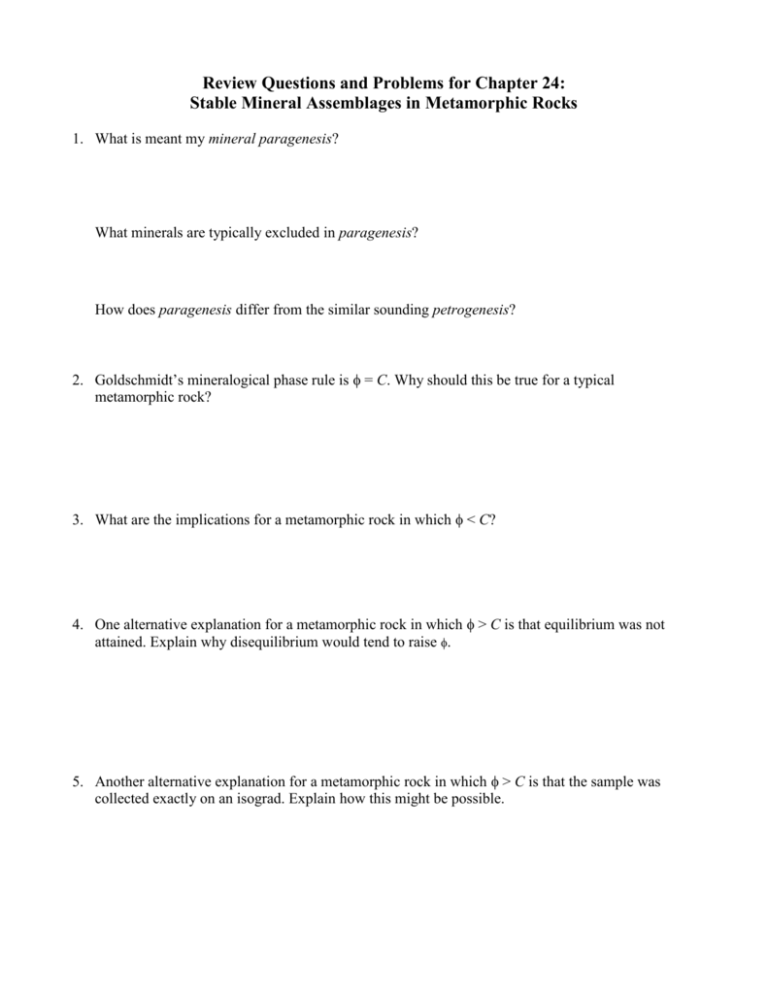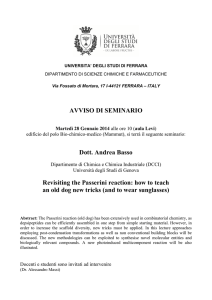Rocce metamorfiche: domande e problemi di revisione
advertisement

Review Questions and Problems for Chapter 24: Stable Mineral Assemblages in Metamorphic Rocks 1. What is meant my mineral paragenesis? What minerals are typically excluded in paragenesis? How does paragenesis differ from the similar sounding petrogenesis? 2. Goldschmidt’s mineralogical phase rule is = C. Why should this be true for a typical metamorphic rock? 3. What are the implications for a metamorphic rock in which < C? 4. One alternative explanation for a metamorphic rock in which > C is that equilibrium was not attained. Explain why disequilibrium would tend to raise . 5. Another alternative explanation for a metamorphic rock in which > C is that the sample was collected exactly on an isograd. Explain how this might be possible. 6. A “perfectly mobile” component is one for which the chemical activity is controlled externally to the system, whereas the activity of other components is controlled within the system. As a slight simplification, let’s treat activity as though it were composition. Consider a system of your own creation in which a saline NaCl solution acts as a pore fluid able to flow through a porous container of sand-sized grains of quartz and halite. Devise a simple system in which Na+ and Cl- would be considered perfectly mobile (concentrations controlled externally) and another in which they would not (concentrations controlled internally). Describe the two systems (using the mineralogical phase rule), both before the fluid is added and after equilibrium is attained. 7. Why would NaCl be counted as a component in the mineralogical phase rule in one of your systems in question 6 and not in the other? 8. The figure below is a ternary CaO-MgO-SiO2 (CMS) compatibility diagram for medium-grade metamorphosed siliceous dolomites. H2O and CO2 are perfectly mobile. Begin with a pure dolomite and describe the sequence of equilibrium mineral parageneses for rocks of successively greater SiO2 content. Discuss each paragenesis in terms of Goldschmidt’s mineralogical phase rule. Remember, = C, where is the number of phases, and C is the minimum number of (immobile) components required to describe every phase in a rock. Note that some assemblages will be degenerate. 9. Figure 25.7 (below) is a ternary ACF compatibility diagram for medium-grade metamorphosed basalts. H2O is perfectly mobile, and the parageneses can be treated as three-component systems. The shaded area represents the typical range of metabasalt compositions. Discuss each paragenesis for the shaded range in terms of the full phase rule and Goldschmidt’s mineralogical phase rule. What variables are associated with F when = C and when < C? 10. Why might garnet occur in some medium-grade metabasalts but not in others in the same field area as in Review Question 9? 11. Sketch an x-y-z triangular chemographic diagram with x at the top, y on the left and z on the right (as in Figure 24-2). Suppose you wanted to project a mineral with the formula xy2z2 from the mineral x3y to the y-z pseudo-binary. What would be your formulas for calculating y' and z', and where would xy2z2 plot? Compare the plot point mathematically and graphically. PROBLEMS 1. Given the following mineral compositions (Fe is Fe+2 unless indicated): Staurolite (St) Chloritoid (Ctd) Anorthite (An) Glaucophane (Gln) Vesuvianite (Ves) Calcite (Cal) Epidote (Ep) Kyanite (Ky) Biotite* (Bt) Garnet* (Grt) Muscovite (Ms) Cordierite (Crd) Diopside (Di) Grossular (Grs) Andalusite (And) Hypersthene (Hy) Wollastonite (Wo) (Fe,Mg)2Al9O6[(Si3Al)O16](OH)2 (Fe,Mg)2Al4O2[Si2O8](OH)4 CaAl2Si2O8 Na2Mg3Al2[Si8O22](OH)2 Ca10(Fe,Mg)2Al4[Si2O7]2[SiO4]5(OH)4 CaCO3 Ca2Fe+3Al2O[Si2O7][SiO4](OH) Al2SiO5 KFeMg2[AlSi3O10](OH)2 Fe2.1Mg0.9Al2[Si3O12] KAl2[AlSi3O10](OH)2 (Fe,Mg)2Al4Si5O18 .H2O Ca(Fe,Mg)Si2O6 Ca3Al2Si3O12 Al2SiO5 (Fe,Mg)SiO3 CaSiO3 * I picked an intermediate composition rather than one of the end-members. Show your calculations for all of the following: a) Calculate and plot St, Ctd, Ves, Cal, An, Glc, and Ep on an ACF diagram (next page). b) Calculate and plot Ky, Bi, Grt, and Ms on an AKF diagram (next page). c) Calculate and plot Bt and Grt on an AFM diagram (projected from Mu, page 8). You are studying a suite of rocks from a field area. You notice that the rocks contain the following mineral assemblages: And-An-Crd An-Di-Grs An-Crd-Hy An-Hy-Di Grs-Di-Wo d) Calculate and plot these assemblages on an ACF diagram (page 8, plot the minerals, and connect coexisting phases with tie-lines). What metamorphic facies is represented (see Chapter 25)? Why do some rocks have cordierite and others diopside? 2. As a review of some important concepts from this and previous chapters, and a preview of things to come in the following chapters, consider the figure below (Figure 27.1). a. Look up the formulas and balance the reaction jadeite + quartz = albite. b. Do the reaction and figure suggest that the molar volume of albite is high or low, compared to that of jadeite and quartz? Explain. (See Section 5.4.3 if you need to review.) c. Where on the diagram is albite stable? Explain. d. Where on the diagram is jadeite stable? Explain. (Hint: Review the second Important Concept in this chapter). e. Another reaction is possible in the same Na-Al-Si-O system: jadeite = albite + nepheline. Nepheline has an end-member formula NaAlSiO2. Balance the reaction. f. The reaction in part (e) has a slope similar to the first reaction. Draw a possible equilibrium curve for the new reaction (properly labeled with reactants on each side) on the P-T diagram. Does it occur at a higher or lower pressure?* On what principle(s) do you base your answer?* Once you have added a properly labeled reaction to the P-T diagram above, draw an isobaric traverse across the reactions and discuss what might occur during both heating and cooling. *Note that the relationships you seek are entirely general. They are based on your answers to parts (c) and (d) above and you do not need any more specific information than you have before you. A “trial-and-error” approach on the P-T diagram should work for this.











